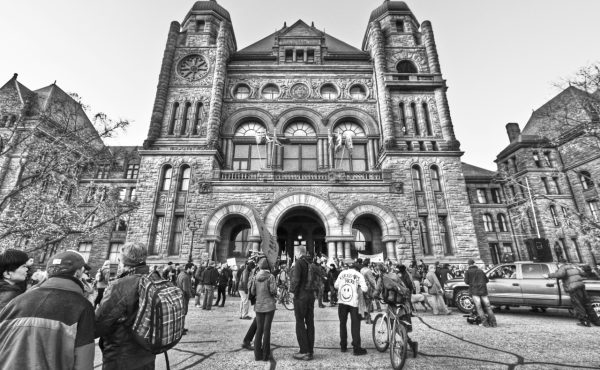Urban consultant and former councillor Richard Gilbert has a very interesting op-ed in the Star today arguing that each of the proposed new subway stations on the Spadina line to York should be accompanied by a medium-density neighbourhood built around it that would ensure that ridership would increase enough to pay for the new station over the long term.
To me, his most important point is that such new neighbourhoods, made up of mid-rise (7 storey) buildings, would need to be mixed-income. Lower-income citizens are more likely to take the subway, but most new dense developments in Toronto are primarily geared to people with higher incomes (and, often, who don’t have families).
Gilbert argues that the only way for this proposal to happen would be to create a kind of independent non-profit development corporation, with extensive powers, to oversee the work. It is depressing to think that the city government has become so helpless that no-one can imagine it managing this kind of transformation itself.
My main question for the proposal is whether the subway line has the capacity to handle the proposed number of new riders. It might work if there were commuting destinations at the north end of the line so that the load went both ways — which would mean building places along the line where York students might live, and building offices and other workplaces at the northern stations of the line.




15 comments
…or, we could build subways where the densities required to support them already exist or are planned to exist soon–say, along the waterfront and in the eastern and western thirds of the old City.
A radical concept, I know.
All the power to the TTC and the city if they can do this. Making public transit self-sufficient will effectively break the vicious cycle of relying on governments to provide funding only to have capital expansion tied to political favourtism (eg: building a $2B subway out to Sorbara’s Vaughan riding, or the Sheppard subway in Mel Lastman’s backyard).
I think that Hong Kong’s MRT system turns a profit, but it also owns (I might be wrong; experts please correct me)the air rights on top of stations which it leases to developers, providing a substantial portion of its revenues.
i say the ttc should just build a high rise building on top of the station. apartments would be available for rent or ownership and everythign would go to the ttc! budget problems solved! 😉
hong kong’s MTR is based on the zonal fare payment, that is the reason why they are able to expand so much because of the profit they can make, while us north americans will complain about a fare higher than $2.50 CND, when i was there last summer i paid around $23 CND just to travel arcoss the system
For whatever reason, I always fear that if new neighbourhoods are built around subway stations the result will be something like whatever is happening around North York City Centre. Unfounded?
I also wonder why we should build new high/medium density neighborhoods when large swaths of the neighborhoods surrounding existing subway lines, like Bloor-Danforth east of Broadview, are low density and could use some serious intensification.
I would support a zonal fare payment; it’d encouage riders with short distances to go to dish out the cash, rather than be frugal and walk. But as to not punish riders who travel farther daily distances, a maximum cap has been suggested — perhaps up to 8 dollars for a ride across the system? It would certainly encourage frequent riders with long commutes to buy passes.
HK has an impressive system; the TTC really ought to look at its ways of operation and financial management. There doesn’t seem to be much reason why the TTC can’t be run like a business and yet still exist as a public service.
Did anyone else find it ironic that the 3 neighbourhoods that Mr. Gilbert mentioned in the piece as being examples of what he wanted to do – King and Spadina, West Donlands and St. Lawerence – are all without any subway service?
I think the problem with zone fares right now is the current fare collection system. Once the GTA fare card system is completed by the GTAA, I’d like to see both zoned fares, plus (I hope), fare integration – allowing you to take transit in Mississauga, Toronto, York, Durham and GO on just a single payment (swiping on entry and exit).
Mike:
What kind of intensification are you talking about? Ripping down the vibrant and relatively dense Danforth strip and building high density condo developments? Maybe if it was 1906 and not 2006 and we still knew how to build stuff that approximates the Lower East Side, but you’re absolutely correct in saying that whatever we build today is more like North York Centre in form. Of course, if we build North York Centres along the Sheppard or Spadina line extensions I could care less.
Leonard:
I should have been more specific. Rather than bulldoze the Danforth, I think it could do with an infill project or two. Not large condos, but a couple of extra stories where the opportunity arises. The area is also rich in alleyways, another opportunity to up the density.
East of Pape is a better case. The Danforth is more or less exclusively two-storey, and the residential area to the north, slowly bleeding into East York, is fairly suburban. During rush hour, very few passengers seem to get on or off the subway between Chester and Woodbine.
During rush hour, very few passengers seem to get on or off the subway between Chester and Woodbine.
That’s because the surface routes in that area mostly run east-west with buses terminating at Broadview and the 506 and 501 going downtown so there’s almost nothing feeding into those stations.
Sounds like a fine idea, but I know a transit system in Toronto that needs this more: GO. In Chicago a very similar system of radial trains spokes out from the Loop (downtown Chicago) and at each suburban stop there is usually parking along a narrow median next to the rails then a small medium density “downtown” area with shops, condos, townhouses and such meaning that many people who use these trains are within walking distance, and there is still parking for those coming from slightly farther. This has as much to do with the fact that many of these suburban lines have been running for 100 years and so a different planning mode was in place. Instead GO has opted for skipping central downtowns (like Oshawa’s) for massive parking lots that require one to drive to take the train, a bit oxymoronical.
But…more density more passengers, no?
Dave: people are trying to change the density situation around GO stations. I know that there is a big fight between Walmart and the Burlington City Council. Walmart purchased land close to the GO station in Burlington, and wants to build a superstore there. Burlington, though, wants to see the land used for higher density projects. I believe the decision is currently in front of the OMB.
The current Mayor of Burlington, Rob McIsaac is steping down this year, and is one of the names mentioned to head the Greater Toronto Transportation Authority.
Matt and Leonard: Hong Kong doesn’t mess around with air rights. They capture the value of subway building directly. Unlike the temporary development corporations that work well in Madrid (and which Richard Gilbert recommends for the Spadina extension) MTR is a permanent entity that makes about 85% of its profit as the primary property developer atop stations and in the station catchment areas. The rest of its profit comes from the Octopus card (an electronic fare card that doubles as a very popular debit card and gives MTR real-time data about how the system is really used) and transit operations, which obviously work best in dense, pedestrian-friendly mixed-use areas that are abundant in HK. MTR works so well, it has been a good performer for investors on the Hang Seng index. Malcolm Gibson, a Kiwi-born MTR exec, says the key for that city is that they realized (while track and tunnels are costly) stations are gold mines if you put them in the right places. Alas, we have very little subway-supportive densities and built form in Toronto, but we are going to lose someof what we have if we don’t get back to building real rapid transit in the areas of town where the trains would be packed from opening day. For the past 30 years, when we’ve built subway at all, we’ve been wasting a large urban-style investment on suburban-form regions of old Metro, places where the sidewalks are empty, even if the city pays to have them shovelled in winter. A big, wide U-shaped line that hooks in with GO stations at Union, Dundas West and Main Street should be priority 1 — it’s two decades overdue. Taken to its logical extensions, it would create a full loop that would eventually get Sheppard to start paying off its long amortization. This line would kick-start waterfront development, multiply the worth of our downtown streetcar routes and stop the slide into car-dependence of areas such as the Distillery, lower Bathurst and Liberty Village.
Cheers, lads
The government of Ontario has a new policy document (relatively new) to support the Places to Grow Act. The plan, simply called the “Growth Plan for the Greater Golden Horseshoe” found at this website: http://www.pir.gov.on.ca/userfiles/HTML/cma_4_44867_1.html articulates the government’s opinion on this very issue.
Anyway, I personally think the plan is rather forward looking in its directives to municipalities in the region to, within 2-3 years time, retrofit their official plans so that 40% of all development comes inside the build-up area. According to this plan, which is supported by an Act of law, intensification will have to take place in downtown cores or along transit corridors, such as buslines, streetcar lines, GO transit lines, etc. What this article proposes is exactly what is law. Getting it done is a the tricky policy task and will take cooperation from local and provincial officials and developers.
Intensification is the only viable option for the area surrounding Toronto. But intensification doesn’t have to mean 50 story condos in the middle of Oakville or some random neighbourhood in Oshawa. It just has to be smart development, including forbidding Wal-mart from building along transit ways in Burlington and encouraging development near Vaughn and York U to sustain the Spadina expansion. If these initiatives fail then there is no point in having public transit.